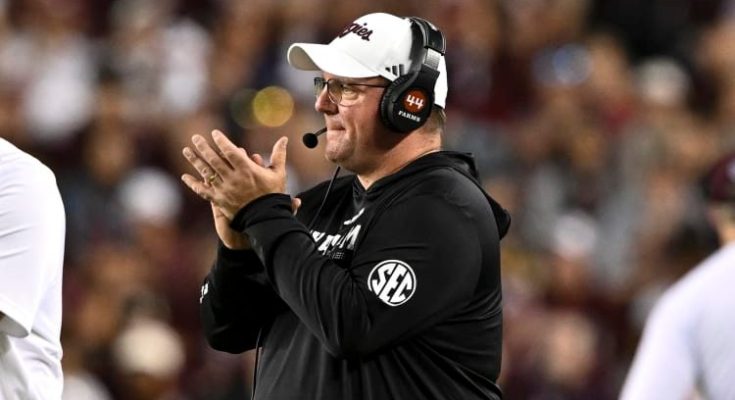Texas A\&M’s football program has long been one of the most scrutinized and analyzed in the nation, not just because of its location in the talent-rich state of Texas, but because of the expectations, tradition, and vast resources that define the Aggies. And now, more than ever, those expectations are beginning to align with reality. The whispers are getting louder, the recruiting classes are stacking up, and the dominoes of development, culture, and elite talent acquisition are beginning to fall in Texas A\&M’s favor. The Aggies aren’t just aiming to be competitive in the SEC — they might be recruiting their way to a national championship.
Over the past decade, Texas A\&M has undergone a transformation that is still in motion but already bearing significant fruit. Facilities have been upgraded to rival any in the country. The commitment from donors and boosters remains unwavering. And while coaching changes have left occasional question marks in their wake, the consistent through-line has been the program’s dominance on the recruiting trail. Whether it’s securing blue-chip talent from within the Lone Star State or plucking elite players from rival territories, Texas A\&M has shown a fearlessness and tenacity that now threatens to rewrite the balance of power in college football.
In the SEC, recruiting is a bloodsport. The margin between championship contender and mid-tier irrelevance is often defined not by effort, but by execution. Texas A\&M has been relentless in executing their vision. The 2022 class set off seismic waves when it finished as arguably the greatest recruiting haul of all time, loaded with five-star defenders, elite linemen, and skill-position players who could start at most Power Five schools as true freshmen. And while some of those prospects didn’t pan out or transferred in the chaos that followed, the impact was unmistakable. That class signaled that Texas A\&M could, and would, go head-to-head with Alabama, Georgia, and LSU for the nation’s top talent—and win.
Recruiting momentum is not just about one class, however. It’s about sustainability. And that’s where Texas A\&M has quietly been outmaneuvering its critics. Under new leadership and with a renewed sense of vision, the Aggies have doubled down on regional dominance. The 2025 recruiting cycle has shown flashes of something more potent than a fluke: it looks like a machine in the making. Texas A\&M is again on pace to secure a top-five class, with several high-level recruits either committed or seriously leaning in their direction. And the types of players being targeted are no longer just measurables-over-everything prospects. The coaching staff is zeroing in on system fits, culture leaders, and immediate impact players—guys who aren’t just great athletes, but winners.
That shift in approach is critical because the Aggies have seen firsthand what happens when talent acquisition isn’t paired with culture. In previous years, locker room cohesion was sometimes sacrificed in favor of stacking stars. That strategy worked for headlines but not always on Saturdays. Now, there’s a noticeable change in recruiting messaging. Players are being sold not just on NIL opportunities, facilities, and NFL development, but on a shared mission—something deeper than exposure and draft position. It’s a pitch that resonates with the new generation of athletes who crave both identity and excellence. And it’s working.
The arms race in college football has evolved. Where once tradition and television exposure dictated recruiting success, the era of NIL, social media influence, and brand development has reshaped the landscape. Texas A\&M was ahead of the curve here, investing heavily in NIL infrastructure and becoming one of the most attractive destinations for recruits who understand the financial realities of modern college football. Critics scoffed early on, claiming the Aggies were trying to buy their way to relevance. But in truth, they were simply adapting faster than their peers. In a market-driven era, Texas A\&M became Silicon Valley in shoulder pads—nimble, well-funded, and always one step ahead.
But what makes this current recruiting surge so dangerous for the rest of the college football world is that the Aggies are finally beginning to marry their off-field wins with on-field maturity. Development has improved. Strength and conditioning programs have been refined. The talent that once sat idle or underperformed is now progressing, maturing, and leading. And perhaps most importantly, the coaching staff has stabilized. The play-calling is smarter. The schemes are tailored to player strengths. Mistakes still happen, as they do in any program, but they no longer feel systemic. There is accountability, clarity, and purpose.
Another advantage Texas A\&M now enjoys is the sheer instability of their rivals. Texas is on the verge of rejoining the SEC but has yet to prove it can thrive in that brutal environment. Oklahoma, too, is undergoing transition. LSU is still formidable but not as bulletproof as it was under Ed Orgeron’s 2019 juggernaut. Alabama and Georgia remain elite, but even those powerhouses are entering phases of recalibration—Nick Saban is gone, and Georgia’s once-unstoppable rise is being met with resistance. In that landscape, Texas A\&M sees opportunity. Not just to compete, but to win.
The recruiting battles they’re winning now reflect that opportunity. Elite wide receivers are choosing College Station not just because of the offense, but because they believe in the quarterback development. Top-tier linebackers are coming not just for the scheme, but because they see a pipeline to the NFL. Perhaps most importantly, elite offensive and defensive linemen continue to choose the Aggies in droves. And everyone in football knows that championships are built in the trenches.
The coaching staff’s ability to close on these players—often in tight battles against the likes of Ohio State, Alabama, Michigan, and Georgia—also reflects a shift in national perception. Texas A\&M is no longer viewed as a secondary choice or a regional powerhouse with a ceiling. It’s becoming, in the eyes of top recruits and their families, a national contender with staying power. And when perception changes, recruiting often becomes easier, more self-sustaining. That’s the tipping point the Aggies appear to be approaching.
A major component of Texas A\&M’s recent success has also been its presence in the transfer portal. The coaching staff has navigated this volatile ecosystem with poise, identifying portal prospects who not only fill immediate needs but also buy into the Aggie way of life. This isn’t just patchwork. It’s strategic supplementation. When a program can pull in top high school talent and then fill any roster gaps with seasoned college contributors, it becomes nearly immune to the usual rebuild cycles. That’s how dynasties are built.
Texas A\&M’s 2025 and 2026 schedules are set up for a breakthrough. The home-and-away balance, the timing of key rivalry games, and the spacing of potential trap games offer the Aggies a genuine runway to make national noise. If the quarterback position solidifies, and if the leadership core continues to emerge from these loaded recruiting classes, there’s little reason to believe the Aggies can’t run the table or, at the very least, earn a playoff berth in the newly-expanded College Football Playoff format.
Of course, nothing is guaranteed in college football. Injuries, off-field drama, and coaching attrition can derail even the best-laid plans. But what’s different about this Texas A\&M build is that it’s no longer top-heavy. There is depth now—quality depth that allows for resilience. If a five-star cornerback goes down, there’s a four-star backup ready to step up. If a coordinator leaves, there’s already a succession plan. The infrastructure isn’t just solid—it’s championship-grade.
What remains is execution. The Aggies have recruited their way to the doorstep. Now, it’s about kicking the door in. That means developing quarterbacks who don’t just manage games but win them. It means crafting an identity that travels—winning tough road games in places like Baton Rouge, Tuscaloosa, and Athens. It means becoming bullies on both sides of the ball. And it means rising above the noise and pressure that inevitably comes with expectations.
The fanbase, long-starved for a national title since the days of Bear Bryant and the 1939 championship season, is energized. There’s cautious optimism, but also genuine belief. You hear it in the stands at Kyle Field. You see it in the swagger of the players during pregame warmups. You feel it in the recruiting rooms, where elite teenagers are choosing the Aggies not just because of tradition, but because of what’s being built right now. That belief is powerful. It’s contagious. And it just might be prophetic.
If Texas A\&M continues to stack elite recruiting classes, develop them properly, and blend in mature, battle-tested transfers, the path to a championship becomes less of a dream and more of a plan. The program has been built brick-by-brick, and now the final piece of the foundation—a winning culture rooted in accountability and sustained excellence—is coming into place. The rest of the SEC would be wise to take notice. Because this isn’t just hype. This isn’t just recruiting rankings. This is the early rumble of a program that’s on the verge of something real, something big, something historic. And if the signs are to be believed, Texas A\&M might be closer to that championship title than anyone realizes.



